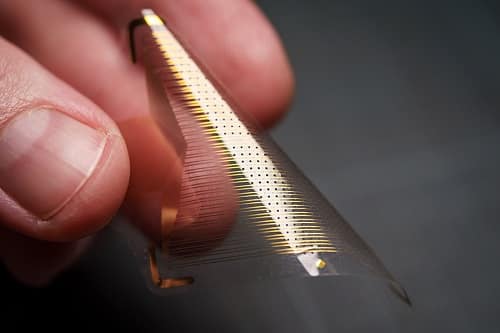It allows high-resolution brain signal recordings to help neurosurgeons and can improve brain-computer interfaces

A team of engineers, neurosurgeons and medical researchers at the University of California San Diego, Massachusetts General Hospital and Oregon Health & Science University has developed a new array of brain sensors that can record detailed electrical signals directly from the human brain.
Featuring densely packed grids of 1,024 or 2,048 embedded electrocorticography (ECoG) sensors, this technology can offer neurosurgeons highly specific information directly from the surface of the brain’s cortex, thus allowing them to plan complex surgeries for treating brain tumours and drug-resistant epilepsy. The technology can also be used for brain implantation and provide electrical stimulation in people diagnosed with paralysis or other neurodegenerative diseases such as Parkinson’s disease and dystonia.
The ECoG grids with sensors can also open new opportunities in neuroscience that could lead to a deeper understanding of how the human brain functions and, in turn, offer improved treatments.
Enhanced sensing system
Recording brain activity from grids of sensors placed on the surface of the brain is already used by neurosurgeons for performing procedures related to removing brain tumours and treating epilepsy. The new ECoG grids can record brain signals at a much higher resolution than currently available sensors.
The sensing system incorporates nanoscale platinum rods that changes its electron count much more sensitively in response to neurons firing in the brain. The platinum nano-rod brain sensor grids are ten micrometres thick, approximately one-tenth the size of a human hair and 100 times thinner than the currently used one millimetre thick ECoG grids. The electrical signals travel from the brain, through the cerebrospinal fluid, and reach the exposed surfaces of the platinum nano-rods, which are embedded in a soft, flexible biocompatible material called parylene.
In contrast to the existing ECoG grids that are one centimetre apart from each other when placed on the brain surface, the new ECoG grids are just one millimetre apart, allowing placement of up to 100 sensors per unit area on the brain’s surface. Despite being close to each other, the individual sensors do not create interference. By covering more areas of the brain, larger signals can be simultaneously collected, unlocking more of the brain’s mysteries.

Challenges & next steps
Removing brain tumours is quite challenging as its presence often triggers the brain to change its naturally assigned functionalities. These changes make it critical for the surgical team to make a personalised ‘functional’ map of the patient’s brain to decide where to cut and where not to cut while removing the tumour. With platinum nano-rod ECoG sensors, the functional map for each individual can be made extremely precise.
For broader clinical use, the researchers aim to get the sensor grids FDA approved soon. The team is also working on developing a wireless version of the high-resolution ECoG grid, which can be used for up to 30 days for monitoring the brains of people diagnosed with incurable epilepsy.









